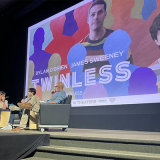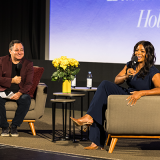
Jon Schnitzer: Probing Near Death or Scared to Death Experiences
June 11, 2018
John Schnitzer (BFA/FTP ’01) is fascinated by things that might stop your heart—literally, or almost. Hence two of his recent projects have an otherworldly connection, one in VR and one a documentary that examines the extreme lengths people go to scare each other on Halloween. His VR experience, Flatline, has been showcased at VR/World New York and is available for Oculus and Vive Port headsets. As co-owner of The Brain Factory, Schnitzer has created horror attractions, VR and immersive experiences for clients such as Tim Burton, YouTube Red Studios, and TASCHEN Books, and produced 3D ghost illusions for President Obama’s 1st Halloween Party at The White House.
Schnitzer also recently released his first feature film, Haunters: The Art of the Scare, a documentary about how haunted houses for Halloween have spawned a growing subculture of extreme full-contact terror simulations. The film is currently being streamed on Netflix.
How did you get started addressing these scary topics?
Seventeen years ago, I met someone who had a near-death experience and his story made the hairs on my neck stand up! I wanted to make a film about it, but then I thought if people just watch this story on a screen, in a film they will just judge and dismiss this powerful experience.
I directed/produced/created/co-developed Flatline Experience, a virtual reality project that gives audiences the ability to become active participants in an actual near-death experience. I made Flatline as a VR project because it wouldn’t work any other way and to me, the only reason to produce a VR project is if it is the only way that story should be told. I believe that VR can use technology to create personal experiences that create empathy that will actually bring people closer together.
Where do you see VR headed?
VR is in a fascinating and un-predictable place right now. I hope VR continues to be used to bring us together in virtual meeting spaces (and provide) travel and adventure opportunities for people who don’t have the ability to travel, skill-based teaching for surgeons, healing for those suffering from PTSD, exposure therapy for people who suffer from extreme fears, stories that can enhance empathy, and games that will open our minds to adventure.
What do students need to know to work in VR?
Students who want to get into VR, AR and storytelling should also focus on psychology, English and history. Understanding human nature, our past and how we communicate will give you the edge over people who have the technical skills, but nothing else. Everyone must have technical skills, but what else are you going to be an expert in that will push you over the edge and make you stand out in a crowd?
And please, understand how 3D (stereography) works and the psychological importance of spatial relationships. Remember in VR and AR the “rule of thirds” doesn’t apply because you’re not creating the illusion of depth, you’re actually creating depth. VR isn’t about cheating; it’s about creating a reality. It can be surreal or realistic, but you’re not filming a set, you’re creating a world in which the audience will become an active participant. Please make an experience that is worthy of the technology. If our experiences don’t blow minds, then VR will die. The future is in your hands.
This article originally appeared in the 2018 spring issue of In Production Magazine. Find the full issue and past issues here.

